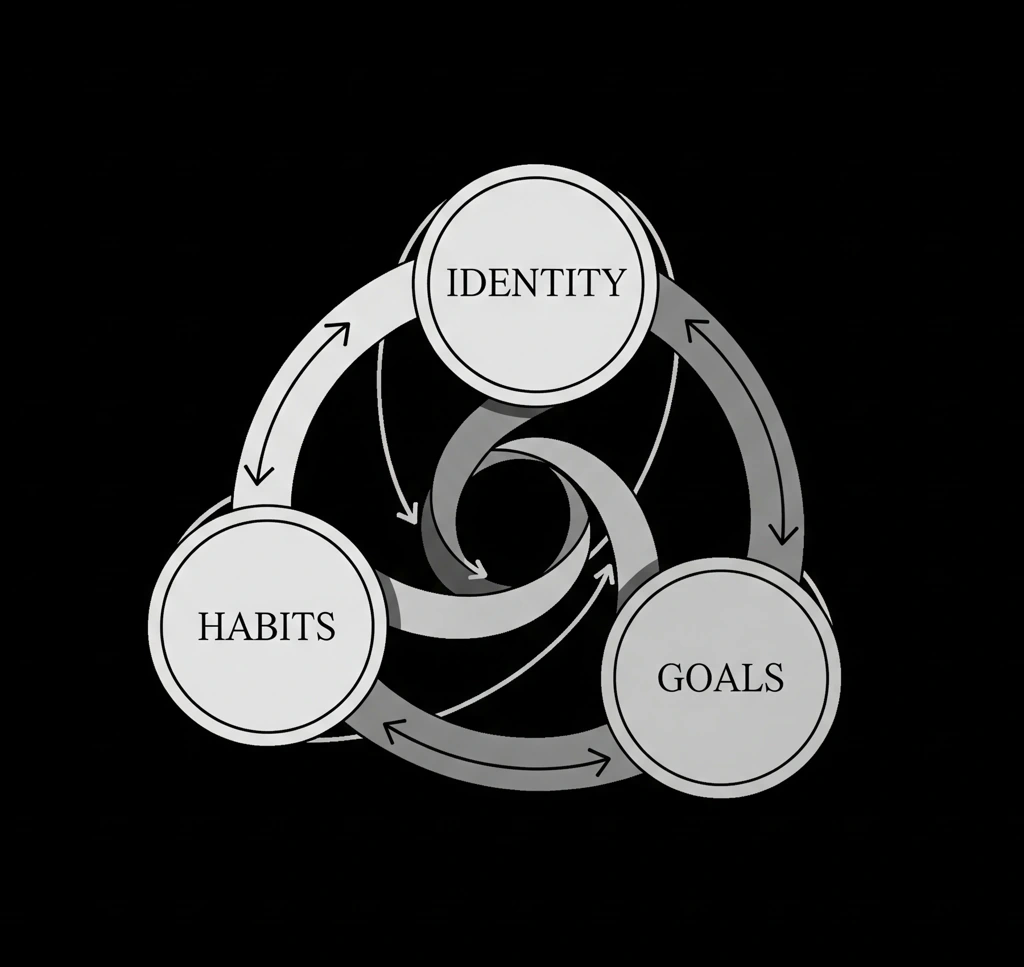However, understanding how these elements interrelate can provide a clearer path to successful personal development.
Identity as the Foundation
Identity is often considered the foundational element that should be addressed first. This is because identity deeply influences what you believe is possible for yourself and dictates the types of goals you set and the habits you form. When you change your identity—or your self-perception—the rest can follow more naturally. For instance, if someone starts to see themselves as a writer, they are more likely to adopt the habits of writing regularly and setting goals that support a writing career.

The Role of Habits
Habits are the actions we take daily that either reinforce or contradict our identity. While changing habits is crucial, doing so without addressing underlying identity issues might lead to short-lived changes. However, new habits can also help to forge a new identity over time. For example, by consistently getting up early and working out, someone might start to see themselves as a morning person and a fitness enthusiast, which can affect other related behaviors and goals.
read more: Turning Difficult Habits into Enjoyable Routines: A Step-by-Step Guide
Setting Goals
Goals give direction and endpoints to aim for, but they need to be aligned with one’s identity and supported by the right habits to be effective. If goals are set that don't resonate with one's sense of self, they might be harder to commit to and achieve. Conversely, goals that resonate with an individual's identity can motivate habits that solidify that identity further.
read also Forget about goals, focus on system instead
A Suggested Approach
-
Start with Identity: Reflect on how you see yourself and how you would like to see yourself. What kind of person do you want to become? This might involve shifting self-perceptions and challenging existing beliefs about your capabilities.
-
Develop Supporting Habits: Once a desired identity is clearer, establish habits that support this new view of yourself. This step is about putting your identity into practice through regular actions that reinforce who you want to be.
-
Set Aligned Goals: With a solid identity foundation and supportive habits, setting and achieving goals becomes more feasible. Goals at this stage should not only reflect your ultimate aspirations but also be stepping stones that consolidate your evolving identity and habits.
In essence, focusing on identity first can provide a more holistic and enduring approach to personal change. By aligning your identity with supportive habits and goals, you create a synergistic effect that can greatly enhance your chances of long-term success.
But..
Thinking about your goals first can indeed help to clarify what identity shifts might be necessary to achieve those goals. Let's break down this approach:
Start with Clear Goals
Beginning with a clear set of goals can be very motivating and provide a direct focus on what you want to achieve. For instance, if your goal is to run a marathon, this sets a clear target. Goals give you a destination.
Define the Identity That Supports Those Goals
Once you have your goals outlined, you can then ask, "What kind of person achieves these goals?" This helps in crafting the identity you need to adopt. For the marathon example, the identity might be that of a runner—a person who values fitness, discipline, and endurance.
Develop Habits That Reinforce This Identity
With the identity defined, the next step is to establish habits that support this identity. For becoming a runner, habits might include daily training, proper diet, and regular participation in shorter races leading up to a marathon. These habits solidify the identity and make achieving your goals more likely.
Evaluate and Adjust
As you progress, it's crucial to continually reflect on and evaluate how well your identity and habits are aligning with your goals. Sometimes, as we delve deeper into our pursuits, our goals evolve, and our identity and habits must evolve with them.
Summary
Starting with goals can provide a clear endpoint and can be particularly useful for people who are goal-oriented and motivated by achievements. By setting goals first, you define what you want to achieve, which then informs the identity you need to adopt and the habits you need to cultivate to support that identity. This approach ensures that everything is aligned and directed towards achieving the specific outcomes you desire.
Reflecting on the interaction between identity, habits, and goals, it becomes clear that this relationship can often form a cyclical process. Starting with a goal can spark the definition of a necessary identity, and establishing habits to support this identity helps in achieving the goal. Once a goal is achieved, this success can reinforce or even redefine one’s identity, leading to the setting of new, higher goals. This cycle of reinforcement between identity, habits, and goals creates a dynamic process of continuous personal growth and improvement. Each component feeds into and strengthens the others, making it less about a linear progression and more about a synergistic cycle that evolves as you do.